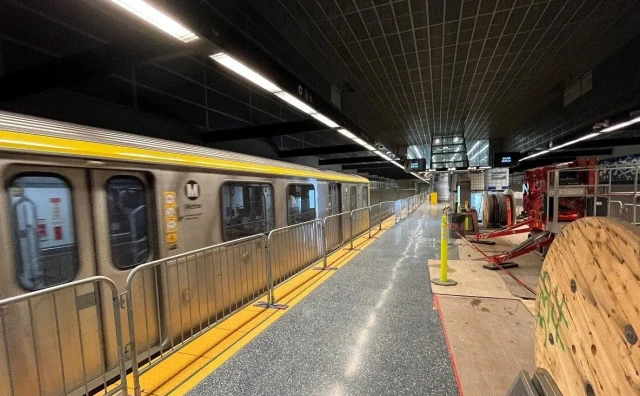With our free press under threat and federal funding for public media gone, your support matters more than ever. Help keep the LAist newsroom strong, become a monthly member or increase your support today during our fall member drive.
Griffith Park's Links to the Locals
Griffith Park's rolling chaparral hills, winding deer trails, and cinemascope views stretch from the Pacific to downtown Los Angeles.
While people head toward the park from L.A.'s busy streets, sometimes scruffy coyotes traverse the short walk in the opposite direction — their eyes glowing in car headlights.
Being so close to something that feels so wild — like real, old, pure California — defines life here.
For people outside the neighborhood, what defines Griffith Park is its size; its 4,210 acres make it one of the largest urban parks in the country.
Its history is closely linked to that of Hollywood. The 50-foot-tall Hollywood sign, arguably the most famous sign in the world, sits on scrub-covered Mount Lee inside Griffith Park.
It was built in 1923 as a gigantic outdoor ad for the Hollywoodland housing development. Over the years the "land" suffix disappeared, along with the housing development, and the 4,000 light bulbs that once acted as a shout-out no longer shine.
The tall, white letters act as a beacon to guide residents home.
Beyond this most apparent tie between the park and the movies, other longtime links also linger.
Many films, commercials and television shows have been filmed in Griffith Park over the years, from DW Griffith's Birth of a Nation, to the first Star Trek series.
James Dean's famous knife-fight scene in Rebel Without A Cause was filmed in Griffith Park, at the hilltop observatory.
That 70-year-old landmark, where visitors crowd to view the other kind of stars, just re-opened a few months ago after a $93 million makeover.
The land from which the boundaries of Griffith Park were drawn was once Rancho Los Feliz, given to Corporal Vicente Feliz by California's Spanish governor Felipe de Neve in the late 18th century.
Griffith J. Griffith, a Welsh mining speculator, bought what was left of the rancho a century later. The millionaire donated more than 3,000 acres to the City of Los Angeles to form a public park in his name, and also donated the funds to build the Greek theater.
"It must be made a place of rest and relaxation for the masses, a resort for the rank and file, for the plain people," said Griffith when he bequeathed the land.
Griffith became an astronomy buff after peeking through a 60-inch telescope at nearby Mount Wilson, which was, at that time, the world's largest.
"If all mankind could look through that telescope, it would change the world!" Griffith is quoted as having said.
Griffith and his park are linked to darker history, too. In 1903, he shot his wife, leaving her mutilated and blind in one eye. He served two years in San Quentin prison.
In 1912, he offered the city $100,000 to help fund a public observatory to be constructed inside Griffith Park. City officials refused to take the money.
But a few years after his death in 1919, officials changed their minds; the money was accepted, and building of the observatory soon followed.
What would be America's third planetarium also became part of the construction plans for the observatory building.
Master telescope designer George Ellery Hale, who directed the creation of the Mount Wilson telescopes and others, was drafted to create the instrument, along with Caltech physicist Edward Kurth.
Observatory architects relied on Russell W. Porter as the "concept thinker;" he also was considered the "patron saint" of what was then a booming amateur astronomy movement throughout America.
Copyright 2022 NPR. To see more, visit https://www.npr.org. 9(MDA1OTI3MjQ5MDEyODUwMTE2MzM1YzNmZA004))
At LAist, we believe in journalism without censorship and the right of a free press to speak truth to those in power. Our hard-hitting watchdog reporting on local government, climate, and the ongoing housing and homelessness crisis is trustworthy, independent and freely accessible to everyone thanks to the support of readers like you.
But the game has changed: Congress voted to eliminate funding for public media across the country. Here at LAist that means a loss of $1.7 million in our budget every year. We want to assure you that despite growing threats to free press and free speech, LAist will remain a voice you know and trust. Speaking frankly, the amount of reader support we receive will help determine how strong of a newsroom we are going forward to cover the important news in our community.
We’re asking you to stand up for independent reporting that will not be silenced. With more individuals like you supporting this public service, we can continue to provide essential coverage for Southern Californians that you can’t find anywhere else. Become a monthly member today to help sustain this mission.
Thank you for your generous support and belief in the value of independent news.

-
Kevin Lacy has an obsession with documenting California’s forgotten and decaying places.
-
Restaurants share resources in the food hall in West Adams as Los Angeles reckons with increasing restaurant closures.
-
It will be the second national day of protest against President Donald Trump.
-
The university says the compact, as the Trump administration called it, could undermine free inquiry and academic excellence.
-
This is the one time you can do this legally!
-
Metro officials said it will be able to announce an opening date “soon.”







